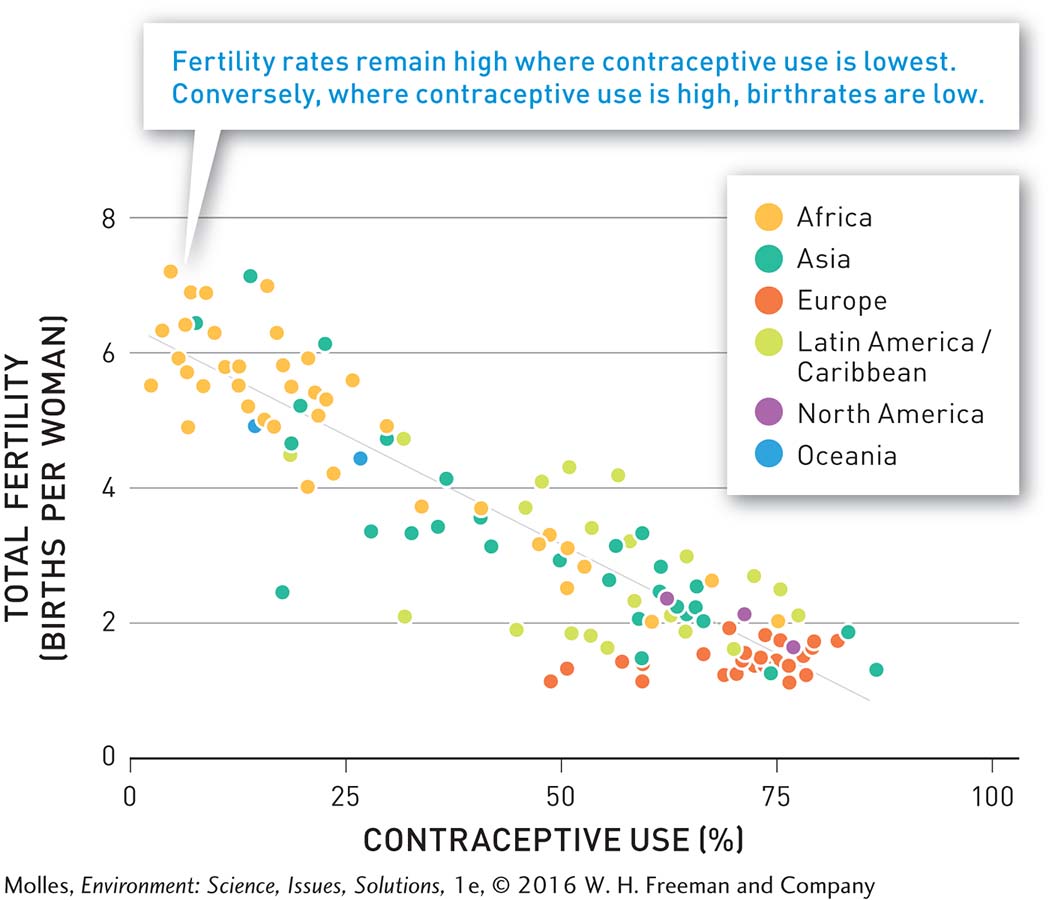Chapter 1. Scatterplot Graphs
Part A: Background
Total fertility rate is a measurement of the average number of children a typical woman will have in a given population.
This number is highly correlated with the years of education available to an average woman in that country. These variables are important in determining why the population growth rate in developing countries is so rapid.

Part B: Examine the Data Set
This data contrasts the average expected years of schooling for girls born in each country with the total fertility rate.
| Country | Expected years of schooling | Projected children per woman |
|---|---|---|
| Australia | 19.6 | 1.9 |
| United States | 16.8 | 2.1 |
| Libya | 16.2 | 2.5 |
| Brazil | 14.2 | 1.8 |
| Indonesia | 12.9 | 2.1 |
| Honduras | 11.4 | 3.1 |
| India | 10.7 | 2.6 |
| Nigeria | 9.0 | 5.5 |
| Ethiopia | 8.7 | 4 |
| Senegal | 8.2 | 4.7 |
| Haiti | 7.6 | 3.3 |
| Pakistan | 7.3 | 3.4 |
| Burkina Faso | 6.4 | 5.8 |
| Niger | 4.9 | 7 |
| Somalia | 2.4 | 6.3 |
Question 1.1
EsyN3NZ+2DrTM8H7DSD7ZWPdzhb0aaVi0zvOyVr2Nec8JPjgcDf0wWRt0YvrKl0/vHVYFT5aNuMDAqpDO8lfZnd6TBPKMWEKtfyI0gBQmIF5VJN5oGBt0s7NiQPDAH7GJV3t7PbIhXqkjQ5dqNA/N4aiWhAnxy6qctbf8FvLfCb7CCU42fxAEnrcEHbqkPEt2jATJ8Y/MRjp8B1eaVmziEC4SzxT6CyU/KidHjDrI9kTEfRMvxQZ8dQyXlX1Hiqo6G4mEWYwVyIcuuyvNrTygg9PNYyisdKeQJQwWT5d4SBVaHqPWS360nBcF5PcJdsVGMYAoQxsTKWjGi0XEPW6aODwGnR+l2SCYSrijMPnyaO80Vrr1A3rt46d65lWUIZaT6ojOPHtaO0JZcRvwy3LtDH3F5+BXQzpo1lcOWP9hYEwo0PanSRvcjpMEH2hY/K0zpKSLwaD7CZXjgwsReEU4eRz4SIWV6tejxsD633zkTxIrDzaWFTTqy6A5f+Ip876Ub3+DfQ38Sj5dgHjYSUztuJPc8AC9MOykRJbrodQT2kxI9zZXb+JJYobk47FTzyoraBLtRO13nH0Oq0bDEXBHA==Question 1.2
7iaFF6JEHeIEDjF3omIj65GtrG/YbXnIlEmKdJJ4TGB8XCou+gJLjJTwUWxB6uuZgHwDowiN3xxJuL4gfozRi0RAoNc3wu6XhcwPlZYDeRfQnLirU7fev6r86wezj0mXUp3T/23Gz3BRbd+u6lOlPHTT39rbtPTaUUtrbce9v4DODN2URisziaf6Ky4QsARZj/7x8Vgo9z+oo+4dNQoHHJk9dMS98+Ik3OBtmWM3X85J92KdZ2mxsJtrR8QoRvQoWOSdBoOV2SAJuoVutlBSJ52Eq7mGnuW/O12/kMNeyNWzuSOP8tbk9jLY+FSccsuJeTa6yWQPJOx8+lZ0ho+f6G2EuQcVt9JzBlEBf9KbvZsl3JxAz9b/M5ceehvPMrouyO8y9KyeLAMyK1YuJNOczpMAn1ao82vt3jLHzZ2n6vElYdrII8KbuNMs1wCYzj5YqtNpkMYme1XHc3ur8iWPEbkanmYSRfMlkc2ZoKbYuXQ=Part C: Build the Graph
Instructions: Create a graph below. Begin by giving it a relevant title, such as "Education and Total Fertility Rate of Women.” Label the x-axis “Years of Schooling Girls Receive,” and the y-axis "Total Fertility Rate.”
Next, input the actual data into the graph. Draw a line of best fit through the data points.
| Country | Expected years of schooling | Projected children per woman |
|---|---|---|
| Australia | 19.6 | 1.9 |
| United States | 16.8 | 2.1 |
| Libya | 16.2 | 2.5 |
| Brazil | 14.2 | 1.8 |
| Indonesia | 12.9 | 2.1 |
| Honduras | 11.4 | 3.1 |
| India | 10.7 | 2.6 |
| Nigeria | 9.0 | 5.5 |
| Ethiopia | 8.7 | 4 |
| Senegal | 8.2 | 4.7 |
| Haiti | 7.6 | 3.3 |
| Pakistan | 7.3 | 3.4 |
| Burkina Faso | 6.4 | 5.8 |
| Niger | 4.9 | 7 |
| Somalia | 2.4 | 6.3 |

There are four basic kinds of relationships that can be derived from scatterplot data:
| Direct relationships occur when both factors increase or decrease at a constant rate. |  |
| Inverse relationships occur when one variable increases while the other decreases. |  |
| Exponential relationships occur when one factor increases at a much higher rate than the other. |  |
| No relationship is when one variable increases or decreases, while the other does not. |  |
Question 1.3
EDnTnuRDdYLkdp+iGXGEjrMEUBDzgac3bPaE2/ayPHWXgPWnENgfrKPDt3yoCIcDmYzViQ+mX7TFINz4A0xR9vPMkpEhO7Xk1s8M9/dvRl+251sItCUh5EjSzgdIELrympz4ugzjaCkl4KueFT1DxpR7Nc82waRxsVfCw7V6GZ+NZQ525pm6PAFbffeOVb3LGw/lnJvqzLIaUSfy8iQwwKLZBVxKDwZt3/jgS3sKE9ZBUChVmwQq6g+23vlZbLggTPYd+OY7+ld9PfjK0IFoEXMvifCwZCTXzFEJbg==Part D: Apply Skills
Figure 5.21 is another scatterplot graph that shows the relationship between total fertility rate and another variable, contraceptive use.

Question 1.4
fUbB7gl5u0qGCVuFb5CM8By+XdG2xDyA8aOGsE9nkYYkJha1zfzmHrN99TtrHhw1fPnuVbhiBI7YQO92VEVtwPKmWFtdz6ckD+V0fll6gybXXklTjrZDuUrmHYLjmdE7Kopx1bPkHsOt3Y0k30VSSyFsTwBjdcXT4Bs20/2DAuQ9ByDIkC6uK2VI8IKj7XTqfLPkXa1jlsRy9tu63Pu+S82jQVwqVZtdfUnztg==Question 1.5
6+yNfjGIlFlplDQNhtn7+xMiEJv2hllmwnnWm8vo+aKxQkQLvmWKMaEJ13rh5D+UzALEm3+sAKPC7fQGQwbULAmtwbcTNTxaxlQTQN6ctSu0wBn6zwzRmhe2pAaegiIIW0/4NTQere95wC27ABGdbvfVLvlFzMMQMOZEyUu1Gh3WEaALIwOspoxCog85ZPi1T2+1ITM3lj63lDu5gyqKUB1sZYJ+rfp6is3tF45/qjWpcvdNrKcmqeScSNrEmXO40SVKz1F93wZXZxihTzVtfQ==Question 1.6
ELfQToTXgcYMRTqxOCObcVZAJCzsLjEyUOQ6Tnu43ySECJJYJb06GEqCPGOHBaSQQpPkOOvp7GMpNHBBeHHMhuU3pmmcSCLy/PCWYcWKQ49VGsVKgLIsbUozcIvgfSyB16m2063Df6vtTs7H3ITUPrw1AILNbz7jhtQICzEhQUHs4Oq32eerQghT1oUf+cqVUXgPruBVy8IO6k92JXRzeH7AbKbY3bOdzI57+sbdPB9+PrUlvVdfA2JljXpSSZBaDf5jh/xWWsB7PeCb8huX6nPxcSwrBGUnsy3TfTYHweWKRp/VQrxSo4yQ5TmWXZ5hXL9TXuYzz3G++NFkgICBTaKzFwbi+h8kLUCf25r8sntGbT3PysUb+XQmHHd0p/R0wg3b3WlTg4k/X1uWRvWHV9qabAc/y0QzFZ/EAlKnliEpDGTzbq/wKBaD6lUyJEaVc2bR8plAdeTIZj3q3RAx/jW7q9geHlN+OCktxJcgfcILNMArkdz1hD/415A/9rgXkwnuoqEu+/pcpZTHhxQnSY5SPiu8HC5KNNTskCHlQC4JEKT6y2lvLAqZVBsyKf9cCfgJPg==Question 1.7
MUByzF5qjsAK1G2Rj8oE6ek+eKYS7L8rP4QNnUV+4cOWPx/3akLx+xWhAjZ3KrFc3RBjvVYecObeVUgPD0/INRe82soKZBqQGDTc+ON1/JSQYQYJQ+tN40E97MuIdX7WKbtMGOWNw6BiG4Iy6MnrUboiBnahy5hIa92cdy7jzCkQgWntSpBxRVifbHE1E3ePISzJy/+ANV5wKY0Lu7PoGzttzvVGHa6Vxbl1hJ5D9GnsYmgQRAKZUoI5xcQsCJDrdZVtXGpahuFz44Xex9onmnmAvDTCoiwzkmBtmQ==1.1 Activity Completed!
Activity results are being submitted...